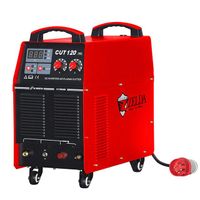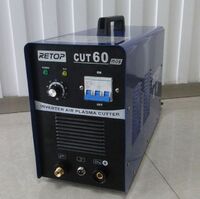Heat Exchanger Diaphragm Automatic Plasma Welding Machine
-
Supplier: Shanghai Duomu Insustrial Co., Ltd. -
Region: Shanghai, China -
Contact: Ms Phaedra Zhan -
Price: $10000.00 /piece -
Min. Order: 1 piece
Product details
| After Warranty Service: | Video technical support, online support | payment terms: | letter of credit, wire transfer |
| Health status: | new | Showroom location: | not any |
| Weight (kg): | 46kg | place of origin; place of origin: | China |
| Core Components Warranty: | 1 year | usage: | welding |
| Warranty: | 1 year | Input voltage: | 380 |
| Video external inspection: | if | Supply capacity: | 499 sets per year |
| Power (kW): | 3.75-25.6 | Dimension Arc (A): | 3-10,3-20,3-20,3-50 |
| After-sales service provided: | Online support, video technical support | product name: | Plasma Transfer Arc Welding Equipment |
| Main selling point: | automatic | Applicable industries: | Petroleum machinery, agricultural machinery, aerospace machinery, metallurgical machinery, water conservancy machinery, construction machinery, mining machinery |
| brand: | woody | Packaging Preview: | |
| Rated current: | 2-125A, 2-160A, 3-300A, 5-500A | Mechanical test report: | if |
| Marketing Type: | normal product | Core components: | engine |
| Local service location: | not any |
Product Description
nation | China |
country model |





Model: dmmp-01
Product Description:Dmmp-01 is a non-standard plasma welding equipment specializing in heat exchanger diaphragm welding. This equipment is the key equipment for the production of fully welded plate and shell heat exchangers. The product has the characteristics of excellent welding seam quality, beautiful shape and high bearing pressure.Heat Exchanger Diaphragm CNC Welding MachineFully welded plate and shell heat exchanger is a new type of high-efficiency heat exchanger suitable for high temperature, high pressure, corrosion resistance and other occasions. It consists of shell, heat exchange plate group, inlet and outlet connecting pipes, flanges, cover plates and brackets. It combines the advantages of detachable high efficiency and shell and tube high temperature and high pressure. Compared with the fully welded plate and frame type, it has higher temperature resistance and pressure resistance, and is an effective substitute for shell and tube heat exchangers. The core component of the heat exchanger is the heat exchange plate group, and the welding quality group of the plates is the key factor of the heat exchanger. The plasma welding equipment developed by our company can effectively solve the welding process problems of the inner and outer rings of the plate group, and make outstanding contributions to the quality of domestic heat exchangers catching up with the international level. Features of this machine: 1. It adopts the precision plasma welding power source independently developed by our company. The whole welding process is controlled by waveform. The welding process is stable and the dynamic quality of the power supply is good. The output control is accurate. 2. Adopt Mitsubishi PLC. 3. Adopt LCD touch screen. 4. The welding power source is connected with the control system through communication, and the welding process parameters are controlled by the program. 5. The welding process is forced cooling, and the deformation of the welded product is small. 6. Inner hole welding: once clamping, double inner hole welding is automatically completed. 7. External welding: once clamping, the whole welding process of the set length is automatically completed. 8. Welding depth, strong tensile strength, high pressure resistance. 9. High degree of automation and excellent welding quality.ApplicationsIt is suitable for welding the inner and outer rings of the diaphragm group of fully welded plate and shell heat exchangers.DML-V03CD Parameters

DML-V03CD PTA welding power source
This article provides the detailed parameters of the welding machine power supply. The automation part is a non-standard customized product. You need to contact us for free detailed design.
Introduction of PTA welding machine
Review of Plasma Powder Surfacing TechnologyPlasma powder surfacing is an advanced surfacing technology, which uses argon plasma arc as heat source and powder alloy as filler. Compared with traditional surfacing methods such as electric welding and argon arc welding, plasma powder surfacing has the characteristics of good surfacing welding and good controllability. Good permeability, high adhesion, good density and easy automation. Therefore, it is also the necessary equipment required by the relevant certification departments when valve companies apply for the special equipment manufacturing license (TS) A-level certification.
1. The working process of plasma powder surfacing equipment
(1) Arc generationThere are two kinds of arc ignition devices inside the equipment, which provide non-transfer arc and transfer arc respectively. The negative poles of the two power sources are connected in parallel and a cable is connected through the tungsten pole (negative pole) of the surfacing torch. The positive pole of the non-transferred arc power source is connected to the nozzle of the surfacing gun through a cable, and the positive pole of the transfer arc power source is connected to the workpiece through a cable. The cooling water is led to the welding torch, cooling nozzle and electrode through the water cooling cable. Argon enters the torch through a solenoid valve and a rotameter. After the power is turned on, the non-transferred arc is ignited by a high frequency spark. The transferred arc is then ignited by the conductive path between the tungsten electrode and the workpiece caused by the non-transferred arc flame. n Keep or cut off. It mainly uses the transfer arc to generate a molten pool on the surface of the workpiece.(2) Solder powder outputThe alloy powder is continuously supplied by the powder feeder as required, and is fed into the welding torch by means of powder feeding gas (usually argon gas) and blown into the arc. The alloy powder is preheated in the arc column, in a molten or semi-molten state, and sprayed into the molten pool of the workpiece, where it is fully melted, and the gas and slag are discharged.(3) Parameter adjustmentThe amount of heat transferred to the workpiece and the molten alloy powder can be controlled by adjusting process parameters such as transfer arc and non-transfer arc current, powder feeding amount, etc. With the relative movement of the welding torch and the workpiece, the alloy molten pool gradually solidifies on the workpiece to obtain the desired alloy deposition layer.
2. Characteristics of plasma powder surfacing welding processCompared with other surfacing methods, plasma surfacing uses plasma arc as heat source and alloy powder as filler metal, which has many advantages.
(1) The cladding speed is fast and the productivity is high.
(2) The penetration is controllable and the dilution rate is low.
The dilution ratio mainly refers to the overlap and fusion of the surfacing layer and the substrate, and its function is to control the bonding strength of the surfacing. The dilution ratio is too small and the strength is low (metallurgical bonding becomes mechanical bonding). If the dilution ratio is too large, the performance of the surfacing layer will be affected, and the shrinkage stress of the surfacing layer will be large, resulting in cracking. Generally controlled at 5% -10%.
(3) The surfacing surface is flat and smooth, with high density, and the surfacing surface of 0.5-5mm can be completed at one time.
(4) A stable surfacing layer can be continuously obtained for a long time, and there are no quality problems such as pores and trachoma on the surfacing surface.
(5) The alloy powder is easy to prepare and can be used for a variety of materials. Cobalt-based, nickel-based, iron-based and copper-based powder welding materials can be selected, and the formula can be directly formulated according to the working conditions.
(6) It can be equipped with special planes, robots, etc. as needed, which is easy to realize automation and reduce labor intensity.
(7) The utilization rate of powder is high, and the utilization rate can reach more than 75%.

E.g
Below I will give you an example of oil plunger wear-resistant coating treatment. I would like to introduce you to the basic process of plasma cladding. For other product processing solutions, please consult our manual customer service.
our service
VIEW MORE
You may like
-
Air plasma cutting machine with built-in compressor

-
5 in 1 Gas MAG TIG FLUX MMA Inverter Welder 200amp Combo MIG Welder Plasma Cutter

-
JONE welding machine plasma cutting machine

-
LGK-100 CNC interface built-in air pump plasma cutting power supply cnc plasma cutting machine laser cutting machine plasma cutting cnc

-
Jinbo Portable Cutting Machine Cuts 40 Cuts 60 Air Plasma Cutting Machine For Sale

-
JONE LGK-40 plasma CNC cutting machine igbt plasma CNC frequency conversion cutting machine

-
3 Phase 380V 120A Industrial Plasma Air Cutter for Cutting Metal 50mm

-
LGK 80 Industrial Built-in Air Pump Portable Plasma Cutting Machine Plasma Cutting Machine Cutting Machine

-
Single Phase IGBT Inverter Air Plasma Cutting Machine CUT-60 Portable 60amp Cutting Machine

-
CT-520 Dual Voltage 220V 110V Plasma Cutting Machine TIG MMA 3 in 1 tig Welding Machine Fast Supply in 10 Days

Related Search
automatic pipe welding machine
cnc automatic mesh welding machine
automatic mesh welding machine
semi automatic mig welding machine china
automatic tank welding machine
automat corner weld machin suppliers
automatic bandsaw blade flash butt welding machine
automatic cheap cnc plasma cutting machine
automatic plastic pipe electrofusion welding machine
inverter welding machine air plasma welder cut 40











